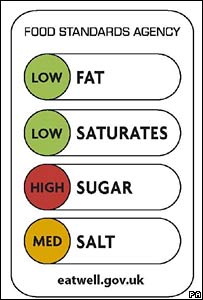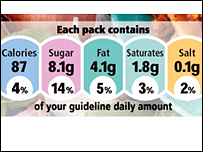
Some of the UK's major food manufacturers are launching a £4m food labelling campaign using a guideline daily amounts (GDA) system, where the labels show percentages of sugar, salt, fat and calories in each serving.
Other companies use the Food Standard Agency-approved traffic-light labels, where green is good and red warns shoppers not to consume too much.
TRAFFIC LIGHT LABELLING
Sainsbury, Asda and Waitrose, the Co-Op and Marks and Spencer have all opted for a traffic-light label.
This is the system the Food Standards Agency would like the whole industry to adopt.
(note: Unfortunately, the food lobbies won the war and the simpler labeling using Traffic Lights was rejected – Author – The Book of Threes)
Its supporters say the GDA system is flawed because many adults do not understand percentages.
The FSA says its research shows traffic-light labels are easier to understand.
"Some consumers do like the extra information that GDAs provide," it said in a statement.
"However, without a traffic light colour code our research showed that shoppers can't always interpret the information quickly and often find percentages difficult to understand and use."
Diabetes UK has described it as the "quickest and easiest" way for consumers to know what their food contained.
From our Have Your Say debate: Paul McLoughlin, from London, said: "The traffic light system is really useful as you can tell, with one quick glance, if the product being purchased is basically, reasonably healthy.
"Having to manipulate percentages, whilst relatively simple consumes more time than identifying a colour and so – for many people at least – will not be performed upon purchase."
Martin Hudson, from Salisbury, also prefers the traffic lights system.
He said: "I'd prefer any labelling to highlight exactly what's in my food especially, when it's additives, preservatives and colouring agents.
"As to the 'healthiness', I think I can decide that myself."
| TRAFFIC LIGHT LABELLING | |||
| Low Per 100g |
Medium Per 100g |
High Per 100g |
|
| Fat | 0-3g | Between 3g and 20g |
20g and over |
| Saturated fat | 0-1.5g | Between 1.5g and 5g |
5g and over |
| Total sugars | 0-5g | Between 5g and 15g |
15g and over |
| Salt | 0-0.3g | Between 0.3g and 1.5g |
1.5g and over |
| Source: Food Standards Agency | |||
The GDA campaign is supported by a coalition of the UK's biggest food and drink manufacturers as well as supermarkets Tesco, Somerfield and Morrison.
The labels show percentages of GDA of sugar, salt, fat and calories in each serving.

GDA labelling shows percentages of guideline daily amounts per serving
|
Members of the GDA group claim consumers will find the percentages of GDAs easier to understand than the FSA's "traffic light" system.
GDA campaign director Jane Holdsworth described it as a "simpler" system.
Twenty-one companies and retailers that use the system have claimed people will not buy products with red labels on them.
From our Have Your Say debate: Lucy Jones, from Manchester, said: "I prefer the GDA system, as in place in Tesco, as I find it more informative.
"I find the 'traffic lights' system, at best patronising and at worst misleading.
"Cheese, for example, has a relatively high saturated fat content but under the GDA system you can more easily see that a small portion doesn't 'break the bank' for your daily limit."
| GUIDELINE DAILY AMOUNTS | ||
| Women | Men | |
| Energy (Calories) | 2,000 | 2,500 |
| Protein | 45g | 55g |
| Carbohydrate | 230g | 300g |
| of which sugars | 90g | 120g |
| Fat | 70g | 95g |
| of which saturates | 20g | 30g |
| Fibre | 24g | 24g |
| Sodium | 2.4g | 2.4g |
| Equivalent as salt | 6g | 6g |
| Source: Institute of Grocery Distribution | ||
Source: http://news.bbc.co.uk/2/hi/uk_news/6231137.stm






























